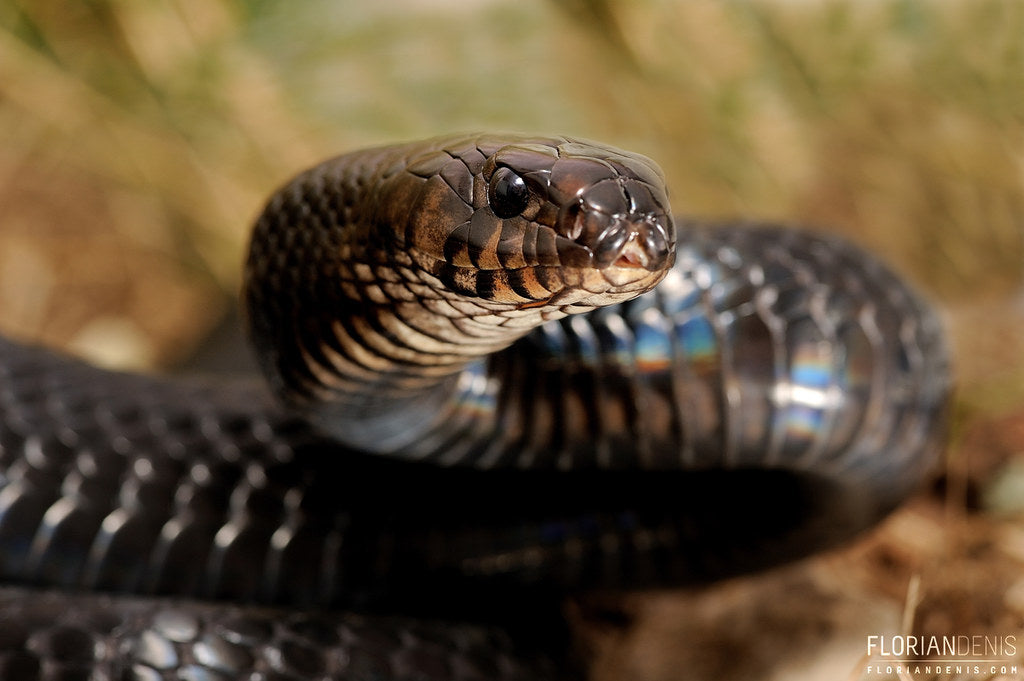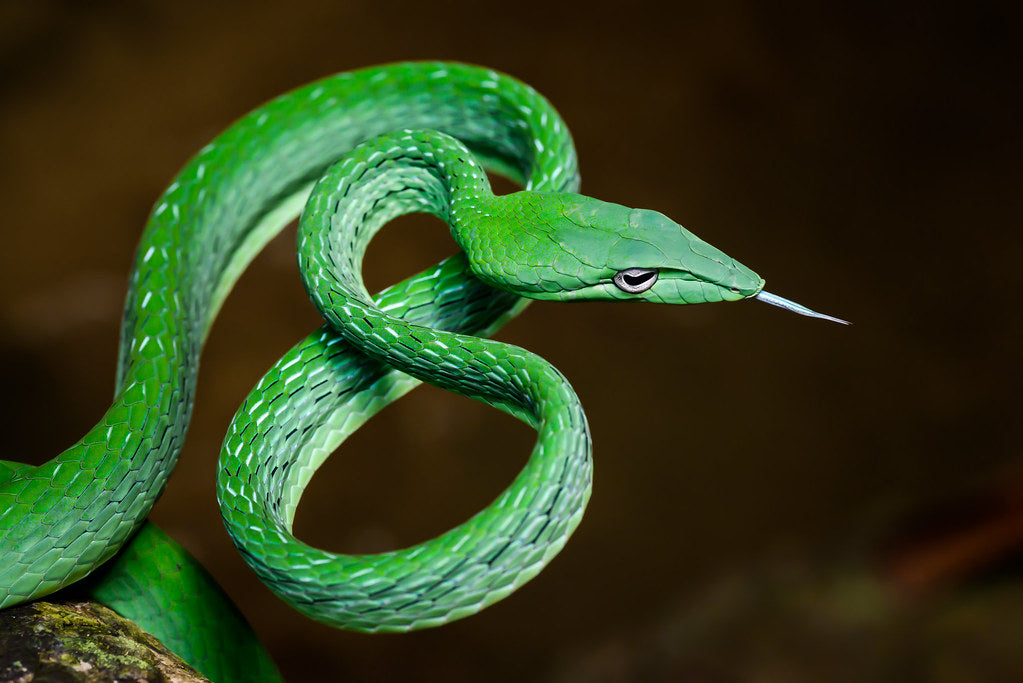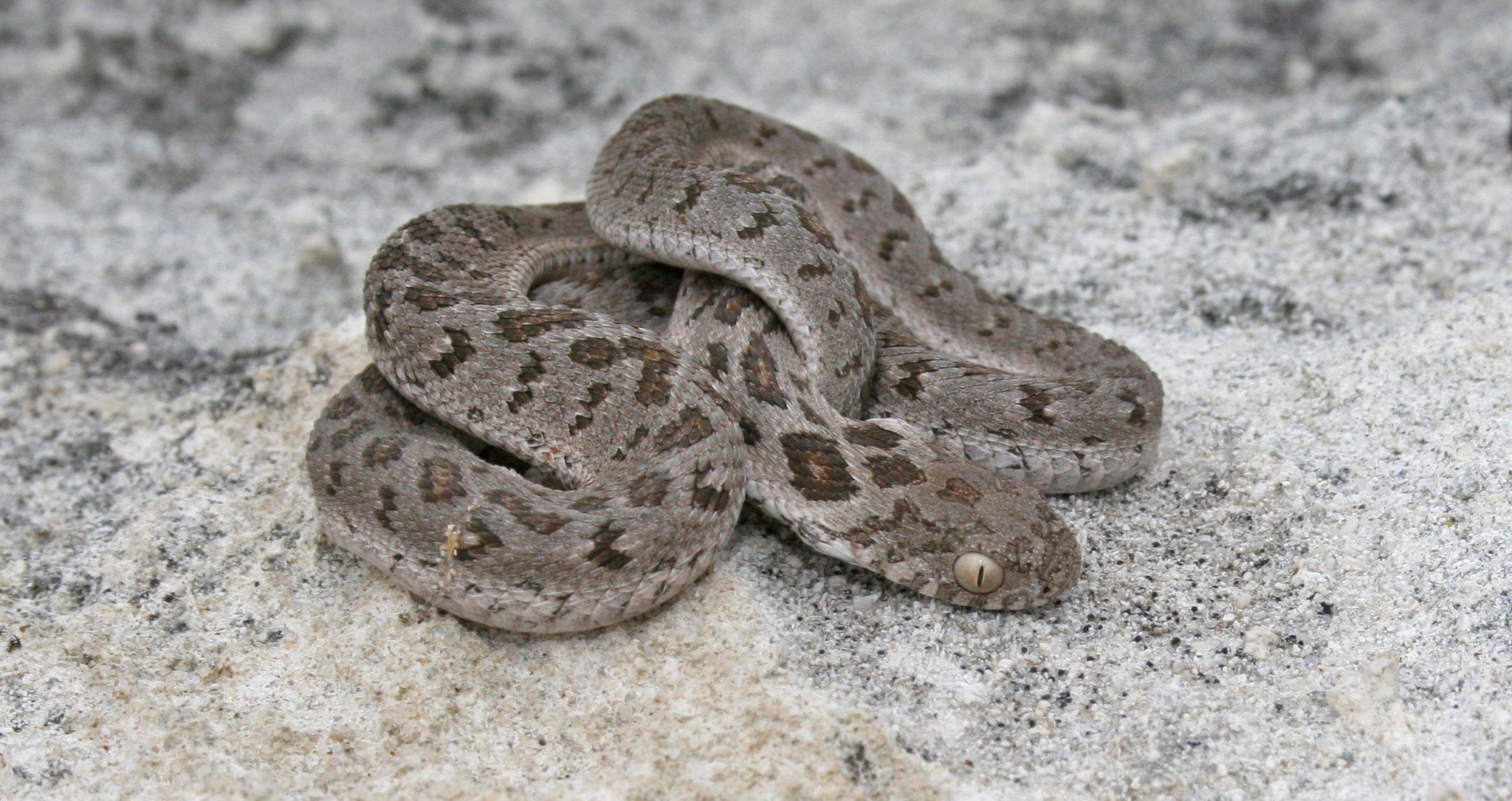Eastern indigo snakes (Drymarchon couperi) are the largest snakes native to the United States, specifically present in the states of Georgia, Alabama, Mississippi, and Florida. These snakes are terrestrial and generally prefer wetland areas for habitat, but they have adapted to live in a variety of other habitats, including prairie, coastal dunes, flatwoods, and scrub.
Eastern indigo snakes are capable of growing up to 8.6’ long, but they are more typically between 5-7’ long, with males being significantly larger than females. This species has a fairly typical colubrid build, with a robust body, oval head, smooth scales, and ridged “eyebrow”-like scales above dark eyes. They are most commonly an iridescent black color all over their body, including the belly, but some have orange-red on the chin and throat.
Eastern indigos are not common pets, as they are a federally protected species with strict exportation laws between states, and typically require a permit to keep. However, their care is similar to a less-restricted species, the Texas indigo, Drymarchon melanurus erebennus. Bear in mind that indigo snakes require much more maintenance than other snakes, so only consider this pet if you have the time and resources to keep up with their needs.
With good care, Eastern indigo snakes are capable of living up to 27 years.
How much space do Eastern indigo snakes need?
All snakes need an enclosure that allows them enough space to stretch out, thermoregulate, and move around as desired. For a large snake like the Eastern indigo, that requires a 6’L x 3’W x 3’H enclosure or larger, particularly for larger adults.
Cohabitation (keeping multiple indigos in one enclosure) is not recommended, as indigo snakes are not a social species, and keeping them together is likely to cause stress. Furthermore, considering that this species is known to eat snakes as a major part of their diet, cannibalism is a very real danger.
Do Eastern indigo snakes need UVB?
They can survive without it, but it’s still best practice to provide UVB lighting for optimal health and wellbeing, particularly considering that Eastern indigos are a diurnal species. UVB gives snakes all of the vitamin D that their bodies need, stimulates better appetite and activity, and generally allows them to be healthier than they would be without.
Eastern indigos do best with low-strength UVB as part of their enclosure. The best UVB bulbs for indigos housed in a 6’ x 3’ x 3’ enclosure are:
- Zoo Med Reptisun T5 HO 10.0, 34”
- Arcadia Desert 12%, 34”
The UVB bulb should be housed in a reflective fixture such as the Arcadia ProT5 or Vivarium Electronics for best output. It must also be placed close to the heat lamp, about 15-17” above the basking area if over mesh, and 18-20” above the basking area if not. UVB is blocked by glass and plastic, so make sure that the fixture your UVB bulb is in does not have a clear plastic bulb cover.
Lights should be on for 12 hours/day, or synced with your local sunrise and sunset times for seasonal variation.
What basking temperatures do Eastern indigo snakes need?
Like other reptiles, indigo snakes are ectotherms, which means that they need a temperature gradient in their enclosure to help them regulate their metabolism and stay healthy.
Indigo snakes should have a basking surface temperature between 90-95°F. On the other side of the enclosure, the temperature should be between 70-78°F. These temperatures should be measured with digital probe thermometers, one on the basking surface and one on the cool side. Heating should be turned off at night, but nighttime temperatures should not drop lower than 65°F.
Provide heat for your snake by imitating the sun with a cluster of four halogen flood heat lamps placed close together one side of the enclosure, positioned over a flat basking surface. Do not use ceramic heat emitters (CHEs), red bulbs, or blue bulbs, as these are not as effective.
If your basking temperature is too hot, use a rheostat or proportional thermostat to reduce the lamps’ heat output. If your basking temperature is not hot enough, you will need higher-wattage bulbs.
What humidity levels do Eastern indigo snakes need?
Indigo snakes are a tropical species, and while they are capable of adapting to drier climates, their distribution indicates that they generally prefer a humid environment. Aim for an average humidity between 60-80%, fluctuating higher at night and lower during the day.
Humidity levels should be measured by a digital probe hygrometer placed in the middle of the enclosure. There should also be a humid hide for your snake, lined with moistened sphagnum moss. Always having a humid retreat is essential for healthy shedding!
Misting your snake’s enclosure with a pressure sprayer first thing in the morning and again at night will help create the right humidity levels. If you need more, moisten the substrate by mixing water into it as needed.
What substrate is good for Eastern indigo snakes?
Eastern indigo snakes produce a lot of waste proportionate to their high metabolism, so an appropriate substrate for this species must not only be humidity-friendly and able to cushion the snake’s body, but it also must be absorbent and easy to replace. We recommend the following substrates for indigo snakes:
Layering clean, chemical-free leaf litter on top of the substrate can also help with humidity, and also provides a great form of enrichment!
Substrate should be at least 4” deep and completely replaced every month. The enclosure should be thoroughly disinfected during this time as well. Remove poop and urates daily, and replace all contaminated substrate.
What décor can you use in a Eastern indigo snake enclosure?
It’s terribly boring for a snake to be stuck in an enclosure with nothing in it except substrate, hides, and a water bowl. It doesn’t matter how big the enclosure is if you don’t put things in it for your pet to use and interact with.
Aside from hiding places, you will also need at least a couple of low, sturdy branches for your snake to climb on, as well as some live or artificial foliage to provide cover. Hollow logs, cork flats, leaf litter, and other items to explore can also be useful!
What do Eastern indigo snakes eat?
Like other snakes, indigo snakes are carnivores, which means that they need to eat whole animal prey in order to get the nutrition that they need. Here is a basic feeding schedule based on snake age:
- Juveniles should be fed every 3-5 days
- Adults should be fed once every 7-10 days
While obesity is definitely something to be avoided with any pet, keep in mind that indigo snakes have unusually high metabolisms, and need to eat more frequently than most other snakes.
Prey items should be relatively small, preferably at least slightly smaller than the snake at its widest point. Although live prey can be used, it’s safest and most humane to use frozen instead. Prey should be completely thawed in a plastic bag in warm water before offering with a pair of soft-tipped tweezers.
Remember, the key to great nutrition is variety! Aside from offering mice and rats, quail, chicks, eggs, green anoles, frogs, and small snakes can also be used to create nutritional variety in your indigo snake’s diet.
Supplements
Snakes can survive without vitamin or mineral supplements, but occasionally using them can help prevent nutritional deficiencies and optimize your snake’s health. We recommend Repashy Calcium Plus LoD.
Water
Your indigo snake should have access to clean, fresh water at all times. Provide a water bowl large enough for the snake to soak its entire body if desired. Change the water daily and scrub the bowl with a reptile-safe disinfectant weekly, or whenever it becomes soiled.
Do Eastern indigo snakes like to be handled?
Few reptiles actually “like” to be held, but indigo snakes have gentle dispositions and generally tolerate handling well. Be gentle, and pick up the snake from below rather than from above. Support as much of its body as possible, and NEVER pick up a snake by its tail!
*This care sheet contains only very basic information. Although it’s a good introduction, please do further research with high-quality sources to obtain additional information on caring for this species.
"Eastern Indigo Snake" by Florian Denis is licensed under CC BY-NC-SA 2.0. To view a copy of this license, visit https://creativecommons.org/licenses/by-nc-sa/2.0/?ref=openverse.




Leave a comment
This site is protected by hCaptcha and the hCaptcha Privacy Policy and Terms of Service apply.